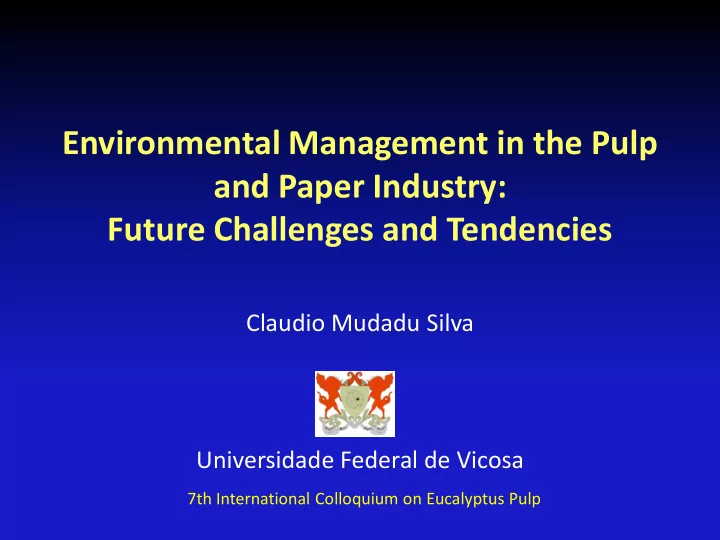

Environmental Management in the Pulp and Paper Industry: Future Challenges and Tendencies Claudio Mudadu Silva Universidade Federal de Vicosa 7th International Colloquium on Eucalyptus Pulp
Presentation Outline • Kraft pulp mill environmental aspects • End-of-pipe versus Pollution Prevention approaches • Water and wastewater – Water use, effluent use (closed-cycle systems), treatment technologies, effluent discharge • Solid waste or valuable by-products – Landfill, land application, energy recovery, other uses • Final considerations
Integrated Pulp and Paper Mill air emissions chemicals water vapour wood paper water Pulp Mill Paper Mill chemicals pulp effluent solid residues solid residues effluent
Environmental Aspects wood cooking liquor chemicals pulp Drier Wood Fiberline Digester Bleaching yard paper Paper mill liquor Black • acidic and alkaline effluent • rejects • air emmisions • bark • effluent • effluent • whitewater Recovery Biomass Evaporation Causticizing lime kiln boiler boiler Cooking liquor • air emmisions • dregs • air emission • air emmisions • contaminated condensates • ashes • grits
End-of-Pipe versus Pollution Prevention
General scheme Air emmisions Raw material Final product Mill water chemicals Effluent Solid residues
End-of-pipe approach Air emmisions Filter CHIMENEA Raw material Final product Mill water chemicals WWTP Effluent Solid residues LANDFILL
End-of-pipe approach • Classical sanitary/environmental control approach • Generally accepted • Little attraction to industry ($)
Effluent Treatment Plant
Landfill
Gas emmisions treatment
Pollution Prevention Approach Any action that reduces or eliminates contaminants at the source, where they are generated, through process modification
Advantages of Pollution Prevention over end-of-pipe approach • Cost reduction • Lower environmental impact risks • Legislation reinforcement (Best available technologies)
Hierarchy Final 4 disposal Treatment 3 Recycling/Reuse 2 Source reduction 1
Water consumption in the pulp industry m 3 /adt Year 1959 240 1969 156 1975 111 1979 96 1985 79 1988 72 1999 60 REEVE, 1999 2015 20-25
Equivalent population compared to water consumption in the pulp industry Considering : • average water consumption of 1 person is around 200 L/d. • a new mill with a production of 3,000 adt/d and a specific water consumption of 30 m 3 /adt. • Total water consumption = 3,000 * 30 = 90,000 m 3 /d • Population equivalent = 90,000/0.2 = 450,000 people
Water closed-cycle systems Closed cycle systems for manufacture of wood pulp of low lignin content, high brightness, strength and cleanliness, that is, bleached chemical pulp, are systems using processes wherein water and other chemicals are recycled and reused and thus waste for disposal is minimized without jeopardizing processing cost or value of saleable products.
Non process elements Negative effects Element deposits Ca, Al, Si corrosion K, Cl, Mg fouling RB K, Cl bleach plant effects Mn, Fe
Examples of potential problems due to effluent reuse
How to tackle these problems ? One approach is to remove the contamination through an in-plant effluent treatment processes prior to water reuse
Effluent Treatment Processes/Technologies • removal of suspended solids (sedimentation, flotation, filtration) • removal of dissolved biodegradable organic matter (biological treatment) • removal of recalcitrant organic matter (coagulation/flocculation, membrane filtration, AOP) • removal of ions (membranes, ion exchange)
How much it would cost to remove contaminants and enable recycling? • Hardly the economic analysis will be favorable to water reuse except if other chemicals are also recovered • Water is still relatively cheap • STILL…
Other driving forces ? • Water shortage • Restrict effluent quality discharge regulations – COD – Color – Nutrients – Toxicity (acute and cronic) – ? ? ? ? ?
Solid wastes or Valuable by-products?
Main by-products generated on a kraft pulp mill NON-HAZARDOUS MATERIAL • Organic – Primary, secondary and sometimes tertiary sludge, dirt bark • Inorganic/Alkaline – Dregs – Grits – Lime mud – Power boiler ashes
Solid by-products (kg/adt) Wood Bleach plant Digester Fiberline Dryer yard Bark 100-200 Recovery Evaporation Caust. Lime kiln Boiler Biomass Boiler dregs grits 10 - 15 2 - 5 ashes 5 - 10 Primary Secondary treatment treatment Secondary sludge Primary sludge 40 - 60 5 - 15
Landfill: an environmentally sound solution or an enviromental passive?
Main use tendencies • Soil amendment (pH, organic matter, nutrients) – composting
Main use tendencies • Soil amendment (pH, organic matter, nutrients) – By-product central
Main use tendencies • Energy production – Biomass boiler, briquetting, anaerobic digestion Other energy Biological sludge sources Dry residues (15%) Exit gas Fine wood Mixture of residues Power boiler Briquettes production Briquettes Donation Commercialization
Main use tendencies • Commercialization (primary sludge for recycling paper production, lime mud, etc.) • Road construction, ceramics, cement
Main legislation tendencies • Avoid landfilling (very high costs) • Gradually more restrictive – BAT - best available technologies
CHALLENGES
Education Educate mill personnel and environmental legislators and authorities about potential of transforming actual “wastes” into “by - products” of commercial interest and environmental sound
Legislation • Review the current concept of residue or waste and describe a legal way to use as a by-product according to its composition and not only according to its origin. • Review constantly the international legislation and foreing experience on this issue
Investigation • Continually investigate options to improve environmentally and economically the use, treatment and/or disposal of the by-product
Final considerations • Water use minimization and reuse – In-plant process modifications – In-plant treatment to remove contaminants – Closed-cycle systems – Water shortage and legislation restrictions • Solid by-products – Find new opportunities for uses (industrial ecology)
THANK YOU!
Recommend
More recommend